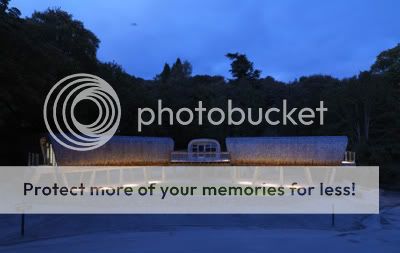Robert Gaukroger, Dan Kealty and Ryan Hartley from KITA Design has just completed this Forest Classroom pods for a prep school in the Lake District, Windermere, UK. This is the first implementation of the Kitahaus Concept by KITA Design. According to The Architectural Review, one of the pod will be a classroom for sixth-year pupils as a transition into secondary school, while the other one will be an environmental learning classrooom.
'The project seeks to find a solution for a new learning facility including classrooms, Art room and external teaching space, by rethinking how a low impact, carbon responsible and sustainable structure can be constructed.'
-Gizmag.
Made from English Chestnut shingles and a ribbed timber frame, the 2 pods are connected by a deck constructed of timber and recycled plastic milk bottles which would later become an outdoor forest classroom during summer. This classrooms buildings are highly insulated because they are raised off the ground by Douglas Fir stilts which reduces heat loss in the winter and aids cooling in the summer.
'The project seeks to find a solution for a new learning facility including classrooms, Art room and external teaching space, by rethinking how a low impact, carbon responsible and sustainable structure can be constructed.'
-Gizmag.
Made from English Chestnut shingles and a ribbed timber frame, the 2 pods are connected by a deck constructed of timber and recycled plastic milk bottles which would later become an outdoor forest classroom during summer. This classrooms buildings are highly insulated because they are raised off the ground by Douglas Fir stilts which reduces heat loss in the winter and aids cooling in the summer.






 Key ecological features of Kitahaus listed by Gizmag:
Key ecological features of Kitahaus listed by Gizmag:*The site’s natural landscaping helps to protect the pods against dominant prevailing winds and the use of structural stilts ensure a low impact of tree roots and the site
* Passive ventilation will be utilised to cool the rooms by the basic principle of cross ventilation. Each pod end has high, openable windows, which assist in ventilating unwanted heat in the space and introducing fresh air to cool the space, the flow of which can be controlled automatically or manually.
* Solar gain can be controlled by automated solar reflective blinds on the glazed area, while the principle of a solar heated, lightweight heat-retaining mass is being investigated
* Timber is a renewable material doesn’t require large amounts of carbon to fabricate, unlike concrete. Its growth also helps absorb carbon gasses. The timber frame construction allows higher levels of insulation to be installed.
* The structure uses sheep’s wool insulation, which doesn’t have the high levels of embodied energy (energy required to manufacture and therefore the quantity of carbon created during production) associated with chemical insulations.
* Vacuum tube solar water heaters will meet all of the classrooms’ hot water needs, reducing the need for a fossil fuel heating. Vacuum tube solar water heaters have a higher efficiency than flat plate solar panels and can be rotated to optimize the sun’s rays.
* The installation will use a grey water collection tank. Water collected from sinks in the art room will be used to water the gardens.
* Flat plate solar panels will be utilised to run low energy lighting.
* Only biodegradable soaps and detergents will be used in the school to reduce heavy metal building up in the soil or water table.
* The Pods are positioned on timber stilts to ensure minimal impact to the natural landscape. When the building comes to the end of its lifespan, it can be removed with little impact to the natural landscape and the building can be recycled and reused for new construction.
* Passive ventilation will be utilised to cool the rooms by the basic principle of cross ventilation. Each pod end has high, openable windows, which assist in ventilating unwanted heat in the space and introducing fresh air to cool the space, the flow of which can be controlled automatically or manually.
* Solar gain can be controlled by automated solar reflective blinds on the glazed area, while the principle of a solar heated, lightweight heat-retaining mass is being investigated
* Timber is a renewable material doesn’t require large amounts of carbon to fabricate, unlike concrete. Its growth also helps absorb carbon gasses. The timber frame construction allows higher levels of insulation to be installed.
* The structure uses sheep’s wool insulation, which doesn’t have the high levels of embodied energy (energy required to manufacture and therefore the quantity of carbon created during production) associated with chemical insulations.
* Vacuum tube solar water heaters will meet all of the classrooms’ hot water needs, reducing the need for a fossil fuel heating. Vacuum tube solar water heaters have a higher efficiency than flat plate solar panels and can be rotated to optimize the sun’s rays.
* The installation will use a grey water collection tank. Water collected from sinks in the art room will be used to water the gardens.
* Flat plate solar panels will be utilised to run low energy lighting.
* Only biodegradable soaps and detergents will be used in the school to reduce heavy metal building up in the soil or water table.
* The Pods are positioned on timber stilts to ensure minimal impact to the natural landscape. When the building comes to the end of its lifespan, it can be removed with little impact to the natural landscape and the building can be recycled and reused for new construction.



























No comments:
Post a Comment